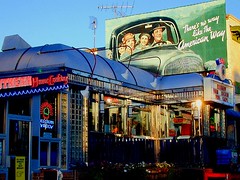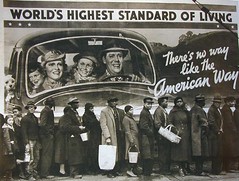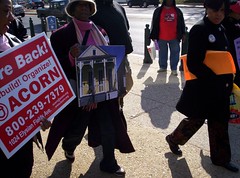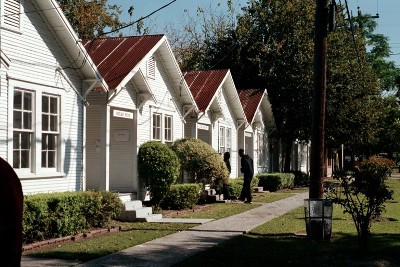New Orleans and DC Perhaps Share Similar Problems
 American City Diner, Connecticut Avenue NW, Chevy Chase, Washington, DC. Image by Pedro Meyer.
American City Diner, Connecticut Avenue NW, Chevy Chase, Washington, DC. Image by Pedro Meyer.The strength of the real estate market in DC, #2 in the world, means that there's a lot of money in the market, and rather than burning holes in people's pockets, they put it to use. Height restrictions contain the size of buildings in significant ways and the need to do deals and value engineering means that the average building constructed since the end of WWII is likely to be a "temporary" building with an expected life of less than 40 years.
Because for most of that time, DC, like most other center cities in the United States, was declining and suffering from disinvestment, especially after the riots in 1968, real estate developers and fellow travelers (like baseball leagues) have had and continue to possess the upper hand vis-a-vis the local community political structure. And it isn't like the politicos would put up much in the way of resistance, as it is downright anti-American to question growth and the always positive impact of "ekuhnahmic duhvellupmint"
 Photograph from 1937 in Louisville, Kentucky, after a flood. Photograph by Margaret Bourke-White.
Photograph from 1937 in Louisville, Kentucky, after a flood. Photograph by Margaret Bourke-White.What this means is that we get a lot of development that is pretty ordinary, and more importantly, anti-livability, because post-WWII development precepts are based around easing the way for automobiles and speeding up traffic, qualities that are antithetical to livable cities.
Fundamentally, the difference between architecture and architects vs. urban design and/or urban planning, and planners, is that the former tend to be unconcerned with connection and context, and focus on constructing buildings as a form of artistic objects while urban designers and planners are supposed to be concerned with building great places.
That is the "schism" between a goodly chunk of the architecture profession right now vs. new urbanism, which for all its faults (in greenfield development) is responsible for the resuscitation and extension of urban design principles.
New Orleans is the battleground today over buildings as art vs. urban design and context-sensitivity and place-making.
 ACORN Protest, near Hart Senate Office Building (Independence Ave. NE), February 9th, 2006.
ACORN Protest, near Hart Senate Office Building (Independence Ave. NE), February 9th, 2006. Better Days. Shotgun Housing in New Orleans' Better Days. Photo: Jerry Krassel, Brooklyn College, City University of New York.
Better Days. Shotgun Housing in New Orleans' Better Days. Photo: Jerry Krassel, Brooklyn College, City University of New York.The architects, led by Reed Kroloff, dean of architecture at Tulane, are putting up a fight, looking at the post-flood denuded (or at least wrecked) landscapes as if they are artists with a palette full of vibrant colors ready to be pressed onto a freshly mounted pristine canvas.
 Old Ninth Ward. Photo: Win Anderson, FEMA.
Old Ninth Ward. Photo: Win Anderson, FEMA.Artforum (it figures that an art magazine has proposals like this) has an article in the current issue, "A Newer Orleans: Six Proposals," showing the latest in avant-gardesm for New Orleans neighborhoods, many possessing buildings at least 100-175 years old, certainly historic even if not designated.
 UN Studio, Mercedes-Benz Museum, 2006, Stuttgart.
UN Studio, Mercedes-Benz Museum, 2006, Stuttgart. MVRDV, Dutch pavilion, EXPO 2000, Hannover. Photo: Robert Hart.
MVRDV, Dutch pavilion, EXPO 2000, Hannover. Photo: Robert Hart. It reminds me of the conversion of most of downtown Washington into meek glass boxes with limited entrances as a different form of a denuded landscape.
 Retail front-ground floor. 1700 K Street NW, Washington, DC. CREDIT: Maxwell MacKenzie/FROM_PHOTOPOST.
Retail front-ground floor. 1700 K Street NW, Washington, DC. CREDIT: Maxwell MacKenzie/FROM_PHOTOPOST. Index Keywords: urban-revitalization



0 Comments:
Post a Comment
<< Home